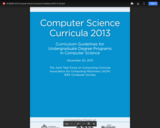
Curriculum guidelines for undergraduate degree programs in Computer Science.
- Subject:
- Applied Science
- Computer Science
- Material Type:
- Primary Source
- Author:
- IEEE
- ACM
- Date Added:
- 02/07/2023

Curriculum guidelines for undergraduate degree programs in Computer Science.
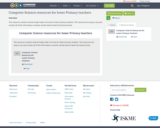
This resource contains several ready made curricula for lower primary students. The resources are easy to use and contain all of the information a teacher would need to teach the lessons/units.

This module depicts the brief overview of Cloud Computing
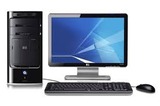
This Module is about Computer Technology

The focus of the course is on medical science and practice in the age of automation and the genome, both present and future.
It ncludes an analysis of the computational needs of clinical medicine, a review systems and approaches that have been used to support those needs, and an examination of new technologies.
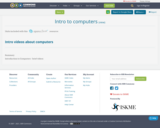
Introduction to Computers - brief videos

Today we’re going to discuss the World Wide Web - not to be confused with the Internet, which is the underlying plumbing for the web as well as other networks. The World Wide Web is built on the foundation of simply linking pages to other pages with hyperlinks, but it is this massive interconnectedness that makes it so powerful. But before the web could become a thing, Tim Berners-Lee would need to invent the web browser at CERN, and search engines would need to be created to navigate these massive directories of information. By the mid 1990’s we will see the rise of Yahoo and Google and monolithic websites like Ebay and Amazon, forming the web we know today. But before we end our unit on the Internet we want to take a moment to discuss the implications of Net Neutrality, and its potential to shape the Internet's future.
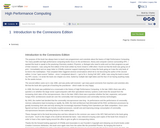
The purpose of this book is to teach new programmers and scientists about the basics of High Performance Computing. Too many parallel and high performance computing books focus on the architecture, theory and computer science surrounding HPC. This book speaks to the practicing chemistry student, physicist, or biologist who need to write and run their programs as part of their research.
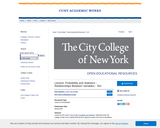
Lecture for the course "CS 217 – Probability and Statistics for Computer Science" delivered at the City College of New York in Spring 2019 by Evan Agovino as part of the Tech-in-Residence Corps program.
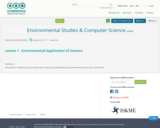
This project outlines the procedures for creating and integrating environmental sensors into a study site.
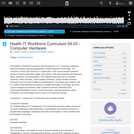
This unit provides a foundation on how a computer functions and how data is represented in memory, input and output devices, and the CPU, including its role in system functionality.
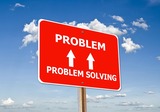
For this 3-part project, students will prepare for programming by practicing the problem-solving steps. They will select a problem that they are dealing with at home, at school, or a problem in the community. They will then research and gather data to help them find a step by step plan to solve the problem.
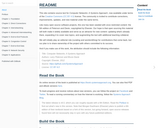
Suppose you want to build a computer network, one that has the potential to grow to global proportions and to support applications as diverse as teleconferencing, video on demand, electronic commerce, distributed computing, and digital libraries. What available technologies would serve as the underlying building blocks, and what kind of software architecture would you design to integrate these building blocks into an effective communication service? Answering this question is the overriding goal of this book—to describe the available building materials and then to show how they can be used to construct a network from the ground up.

This course introduces abstraction as an important mechanism for problem decomposition and solution formulation in the biomedical domain, and examines computer representation, storage, retrieval, and manipulation of biomedical data. As part of the course, we will briefly examine the effect of programming paradigm choice on problem-solving approaches, and introduce data structures and algorithms. We will also examine knowledge representation schemes for capturing biomedical domain complexity and principles of data modeling for efficient storage and retrieval. The final project involves building a medical information system that encompasses the different concepts taught in the course.
Computer science basics covered in the first part of the course are integral to understanding topics covered in the latter part, and for completing the assigned homework.
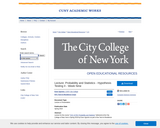
Lecture for the course "CS 217 – Probability and Statistics for Computer Science" delivered at the City College of New York in Spring 2019 by Evan Agovino as part of the Tech-in-Residence Corps program.

This lesson centers around the How AI Works: Computer Vision video from the How AI Works video series. Watch this video first before exploring the lesson plan.
Students learn how computer vision works. They first look at optical illusions to identify the features of the drawing that their eyes noticed. Students watch a video explaining computer vision and how a computer "sees". They design an algorithm that uses a network to decide what number the seven segment display is displaying. Finally, students test their algorithm.
This lesson can be taught on its own, or as part of a 7-lesson sequence on How AI Works. Duration: 45 minutes
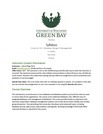
In this syllabus from Fall 2022, Dr. J. David Fleig provides a list of chapters from two OER textbooks. Course topics include: Introduction to Databases; Remote Lab/SQL Server; Database Design/ER Model; Relational Models; Single table queries; Sorting and Aggregation; Subqueries; Multi-table queries; Joins, unions, and more; Primary and Foreign Keys; Create, Alter, & Drop tables; Insert, Update, Delete rows; Table Constraints; Normalization; Views and Temp Tables; From Problem to Design; From Design to Tables; Cursors and Indexes; No-SQL Databases

6.004 offers an introduction to the engineering of digital systems. Starting with MOS transistors, the course develops a series of building blocks — logic gates, combinational and sequential circuits, finite-state machines, computers and finally complete systems. Both hardware and software mechanisms are explored through a series of design examples.
6.004 is required material for any EECS undergraduate who wants to understand (and ultimately design) digital systems. A good grasp of the material is essential for later courses in digital design, computer architecture and systems. The problem sets and lab exercises are intended to give students “hands-on” experience in designing digital systems; each student completes a gate-level design for a reduced instruction set computer (RISC) processor during the semester.
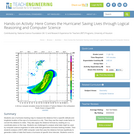
Students use a hurricane tracking map to measure the distance from a specific latitude and longitude location of the eye of a hurricane to a city. Then they use the map's scale factor to convert the distance to miles. They also apply the distance formula by creating an x-y coordinate plane on the map. Students are challenged to analyze what data might be used by computer science engineers to write code that generates hurricane tracking models. Then students analyze a MATLAB® computer code that uses the distance formula repetitively to generate a table of data that tracks a hurricane at specific time intervals. Students come to realize that using a computer program to generate the calculations (instead of by hand) is very advantageous for a dynamic situation like tracking storm movements. Their inspection of some MATLAB code helps them understand how it communicates what to do using mathematical formulas, logical instructions and repeated tasks. They also conclude that the example program is too simplistic to really be a useful tool; useful computer model tools must necessarily be much more complex.
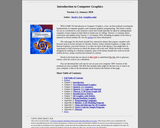
Introduction to Computer Graphics is a free, on-line textbook covering the fundamentals of computer graphics and computer graphics programming. This book is meant for use as a textbook in a one-semester course that would typically be taken by undergraduate computer science majors in their third or fourth year of college.